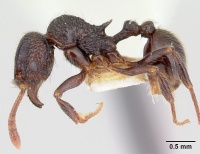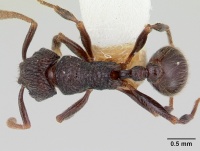Cyphoidris spinosa
| Cyphoidris spinosa | |
|---|---|

| |
| Scientific classification | |
| Kingdom: | Animalia |
| Phylum: | Arthropoda |
| Class: | Insecta |
| Order: | Hymenoptera |
| Family: | Formicidae |
| Subfamily: | Myrmicinae |
| Tribe: | Crematogastrini |
| Genus: | Cyphoidris |
| Species: | C. spinosa |
| Binomial name | |
| Cyphoidris spinosa Weber, 1952 | |
A leaf litter inhabiting species of the forest zone.
Identification
Keys including this Species
Distribution
Latitudinal Distribution Pattern
Latitudinal Range: -0.317° to -0.317°.
| North Temperate |
North Subtropical |
Tropical | South Subtropical |
South Temperate |
- Source: AntMaps
Distribution based on Regional Taxon Lists
Afrotropical Region: Angola, Democratic Republic of Congo (type locality), Ivory Coast, Kenya.
Distribution based on AntMaps
Distribution based on AntWeb specimens
Check data from AntWeb
Countries Occupied
| Number of countries occupied by this species based on AntWiki Regional Taxon Lists. In general, fewer countries occupied indicates a narrower range, while more countries indicates a more widespread species. |

|
Estimated Abundance
| Relative abundance based on number of AntMaps records per species (this species within the purple bar). Fewer records (to the left) indicates a less abundant/encountered species while more records (to the right) indicates more abundant/encountered species. |

|
Biology
Castes
Nomenclature
The following information is derived from Barry Bolton's Online Catalogue of the Ants of the World.
- spinosa. Cyphoidris spinosus Weber, 1952a: 26, figs. 7, 8 (w.) DEMOCRATIC REPUBLIC OF CONGO.
- Type-material: holotype worker.
- Type-locality: Democratic Republic of Congo (“Belgian Congo”): Ituri Forest, 15 miles N Beni, 25.ii.1948, no. 2129.2 (N.A. Weber).
- Type-depository: AMNH.
- Status as species: Bolton, 1981b: 257 (redescription); Bolton, 1995b: 167; Taylor, 2009: 25; Hita Garcia, et al. 2013: 211.
- Distribution: Angola, Democratic Republic of Congo, Ivory Coast, Kenya.
Unless otherwise noted the text for the remainder of this section is reported from the publication that includes the original description.
Description
Worker
Bolton (1981) - TL 3.8-4.3, HL 0.90-0.98, HW 0.81-0.91, CI 88-93, SL 0.68-0.76, SI 83-86, PW 0.60-0.72, AL 1.08-1.22 (10 measured).
Mandibles smooth with scattered pits or at most with faint traces of fine longitudinal striation; number of small teeth on mandible varying from 10-12. Anterior clypeal margin arcuate or with a very shallow impression medially, the median portion of the clypeus raised and bicarinate longitudinally. Main features of head as in generic diagnosis. Eyes of moderate size, maximum diameter 0.16-0.18, about 0.20-0.22 x HW, situated below the ventral margin of the scrobe and in front of the midlength of the sides of the head. Frontal carinae sharply defined, relatively close together and diverging slightly posteriorly but in general not becoming radically broader than the distance across the frontal lobes. At eye level the separation of the frontal carinae is 0.36-0.42, about 0.44-0.46 x HW.
Outline of alitrunk, the promesonotum conspicuously swollen and on a much higher level than the propodeal dorsum. Propodeum armed with a pair of strong spines which are straight to feebly upcurved. Metanotal groove absent; metapleural lobes triangular and conspicuous. Petiole in profile with an elongate peduncle and a well developed node, the dorsum of the node sloping downwards posteriorly so that the posterior face is short. Anterior and dorsal surfaces of postpetiole forming a single convexity, the posterior face truncated. In dorsal view the nodes of both the petiole and postpetiole broader than long. Dorsum of head strongly longitudinally rugose, with 5-7 rugae between the frontal carinae at eye-level. The rugae are irregular and tend to meander slightly, a few anastomoses usually being present. Scrobal area for the most part smooth but usually with 1-2 fine rugulae traversing the width of the scrobe behind the antennal fossa. Sides of head behind eyes finely reticulate-rugose, this sculpture extending round the posterior margins of the scrobes to the occiput. Spaces between rugae everywhere on head unsculptured or at most with the faintest superficial traces. Dorsal alitrunk everywhere finely but strongly reticulate-rugose with broad shining interspaces. Petiole dorsum rugulose, the postpetiole varying from rugulose to only faintly sculptured. Gaster unsculptured. All dorsal surfaces of head and body densely clothed with fine acute hairs. Colour dark reddish brown to blackish brown.
Type Material
Holotype worker, Zaire: Ituri Forest, 15 miles [24 km] N. of Beni, 25.ii.1948, no. 2129•2 (N. A. Weber) (American Museum of Natural History) [examined].
References
- Bolton, B. 1981. A revision of six minor genera of Myrmicinae (Hymenoptera: Formicidae) in the Ethiopian zoogeographical region. Bulletin of the British Museum (Natural History) Entomology. 43:245-307. PDF (page 257, see also)
- Weber, N. A. 1952a. Studies on African Myrmicinae, I (Hymenoptera, Formicidae). American Museum Novitates 1548: 1-32. (page 26, figs. 7, 8 worker described)
References based on Global Ant Biodiversity Informatics
- Bolton B. 1981. A revision of six minor genera of Myrmicinae (Hymenoptera: Formicidae) in the Ethiopian zoogeographical region. Bulletin of the British Museum (Natural History). Entomology 43: 245-307.
- Garcia F.H., Wiesel E. and Fischer G. 2013.The Ants of Kenya (Hymenoptera: Formicidae)Faunal Overview, First Species Checklist, Bibliography, Accounts for All Genera, and Discussion on Taxonomy and Zoogeography. Journal of East African Natural History, 101(2): 127-222
- Taylor R. W. 2009. Ants of the genus Lordomyrma Emery (1) generic synonymy, composition and distribution, with notes on Ancyridris Wheeler and Cyphoidris Weber (Hymenoptera: Formicidae: Myrmicinae). Zootaxa 1979: 16-28.
- Weber N. A. 1952. Studies on African Myrmicinae, I (Hymenoptera, Formicidae). American Museum Novitates 1548: 1-32.

